Design and Optimization of Key Parameters for a Machine Vision-Based Walnut Shell–Kernel Separation Device
Abstract
:1. Introduction
2. Materials and Methods
2.1. Device Design
2.2. Key Components
2.2.1. Material Conveyance Module Design
2.2.2. Acquisition of Simulation Material Parameters
2.2.3. Simulation Experiment
2.3. Object Detection Algorithm
2.3.1. Image Acquisition and Dataset Creation
2.3.2. Algorithm Selection
2.3.3. Algorithm Improvement
- To enhance the model’s ability to detect multi-scale targets and improve its generalization capabilities, a P2 detection head was introduced as the fourth output layer. The corresponding feature map size was 160 × 160, used for detecting small targets larger than 4 × 4, as shown by the red dashed box.
- The Squeeze-and-Excitation Network (SENet) attention mechanism was incorporated to optimize the convolutional neural network [31]. Through automated training, different channel weight coefficients were generated, allowing channels with more critical information to receive greater weights, thereby amplifying the impact of key information. The core structure of the SE module is depicted by the red solid box.
2.3.4. Evaluation Indicator
2.4. Realisation of the Whole Machine
2.4.1. Prototype Building
2.4.2. Working Principle of Prototype
2.4.3. Shell–Kernel Separation Strategy
2.5. Experimental Method
2.5.1. Box–Behnken Design
2.5.2. Artificial Neural Networks
3. Results and Discussion
3.1. Key Components Design Experiment
3.1.1. Simulate Material Parameters
3.1.2. Simulate Experiment
3.2. Experiment of Object Recognition Algorithm
3.2.1. Model Performance Evaluation
3.2.2. Algorithm Recognition Effectiveness Analysis
3.3. Performance Testing of the Prototype
3.3.1. Establishment of the Predictive Model
3.3.2. Optimization and Analysis of the Predictive Model
3.3.3. Validation of the Predictive Model
4. Discussion
5. Conclusions
- A comprehensive machine vision-based design for a walnut kernel separation device has been developed, consisting of material conveyance, image acquisition, control, sorting modules, and a structural frame.
- The designed material conveyance module utilizes differential-speed separation technology, validated through discrete element modeling (DEM) simulations. The results show that the speed difference in the two-stage conveying system effectively transforms the walnut shell–kernel mixture into a spaced particle flow, demonstrating the superiority of this mechanism in addressing material occlusion issues.
- The sorting module employs a matrix of jet components, effectively managing the variable fall times of materials of differing sizes and shapes.
- The improved I-YOLOv8n algorithm performed exceptionally well, achieving a precision of 98.8%, a recall of 98.6%, and an mAP50 of 99.1%, maintaining high confidence even in the presence of material occlusion.
- Box–Behnken Design (BBD) experiments were conducted along with neural network predictive modeling to optimize key parameters. The results indicate that the error between the model’s predictions and the experimental outcomes is less than 3%, demonstrating stability and reliability. Under optimal process parameters, the device achieves a cleaning rate of 93.56%, showing excellent separation performance.
Author Contributions
Funding
Institutional Review Board Statement
Data Availability Statement
Acknowledgments
Conflicts of Interest
References
- Wang, J.; Wang, G.; Zhang, Y.; Zhang, R.; Zhang, Y. Novel Angiotensin-Converting Enzyme Inhibitory Peptides Identified from Walnut Glutelin-1 Hydrolysates: Molecular Interaction, Stability, and Antihypertensive Effects. Nutrients 2022, 14, 151. [Google Scholar] [CrossRef] [PubMed]
- Liu, M.; Li, C.; Cao, C.; Wang, L.; Li, X.; Che, J.; Yang, H.; Zhang, X.; Zhao, H.; He, G.; et al. Walnut Fruit Processing Equipment: Academic Insights and Perspectives. Food Eng. Rev. 2021, 13, 822–857. [Google Scholar] [CrossRef]
- Li, H.; Tang, Y.; Zhang, H.; Liu, Y.; Zhang, Y.; Niu, H. Technological parameter optimization for walnut shell-kernel winnowing device based on neural network. Front. Bioeng. Biotech. 2023, 11, 1107836. [Google Scholar] [CrossRef] [PubMed]
- Liu, M.; Li, C.; Zhang, Y.; Wang, L. Advances and Recent Patents about Cracking Walnut and Fetching Kernel Device. Recent Pat. Mech. Eng. 2015, 8, 44–58. [Google Scholar]
- Zhu, Z.; Kang, M.; Liu, K.; Ma, W.; Shen, X. Theoretical Calculation and Experimental Study on Suspension Velocity of Walnut and Its Main Components after Mechanical Shell Cracking. J. Sichuan Agric. Univ. 2022, 40, 610–618. [Google Scholar]
- Zhou, K.; Meng, Z.; He, M.; Hou, J.; Li, T. Design and Test of a Sorting Device Based on Machine Vision. IEEE Access. 2020, 8, 27178–27187. [Google Scholar] [CrossRef]
- Kumar, D.S.; Esakkirajan, S.; Bama, S.; Keerthiveena, B. A microcontroller based machine vision approach for tomato grading and sorting using SVM classifier. Microprocess. Microsyst. 2020, 76, 103090. [Google Scholar] [CrossRef]
- Sung, H.-J.; Park, M.-K.; Choi, J.W. Automatic Grader for Flatfishes Using Machine Vision. Int. J. Control Autom. Syst. 2020, 18, 3073–3082. [Google Scholar] [CrossRef]
- Sidehabi, S.W.; Suyuti, A.; Areni, I.S.; Nurtanio, I. The Development of Machine Vision System for Sorting Passion Fruit using MultiClass Support Vector Machine. J. Eng. Sci. Tech. Rev. 2018, 11, 178–184. [Google Scholar] [CrossRef]
- Sofu, M.M.; Er, O.; Kayacan, M.C.; Cetişli, B.B. Design of an automatic apple sorting system using machine vision. Comput. Electron. Agric. 2016, 127, 395–405. [Google Scholar] [CrossRef]
- Wang, J.; Bai, X.; Xu, D.; Li, W.; Tong, S.; Zhang, J. Online sorting of surface defective walnuts based on deep learning. J. Food Eng. 2024, 379, 112133. [Google Scholar] [CrossRef]
- Rong, D.; Xie, L.; Ying, Y. Computer vision detection of foreign objects in walnuts using deep learning. Comput. Electron. Agric. 2019, 162, 1001–1010. [Google Scholar] [CrossRef]
- Wang, D.; Dai, D.; Zheng, J.; Li, L.; Kang, H.; Zheng, X. WT-YOLOM: An Improved Target Detection Model Based on YOLOv4 for Endogenous Impurity in Walnuts. Agronomy 2023, 13, 1462. [Google Scholar] [CrossRef]
- Jin, F.; Qin, L.; Jiang, L.; Zhu, B.; Tao, Y. Novel separation method of black walnut meat from shell using invariant features and a supervised self-organizing map. J. Food Eng. 2008, 88, 75–85. [Google Scholar] [CrossRef]
- Wang, T.; Cao, C.; Xie, C.; Li, Z. Design of hickory nut’ shell and kernel sorting system based on fuzzy clustering algorithm. Food Mach. 2018, 34, 110–114+157. [Google Scholar]
- Zhang, Y.; Wang, X.; Liu, Y.; Li, Z.; Lan, H.; Zhang, Z.; Ma, J. Machine Vision-Based Chinese Walnut Shell-Kernel Recognition and Separation. Appl. Sci. 2023, 13, 10685. [Google Scholar] [CrossRef]
- Lin, X.; Li, Y.; Zhu, Y.; Zhou, Z.; Chen, X. Design of grading and sorting mechanical system for Pleurotus eryngii based on differential separation principle. Food Mach. 2023, 39, 57–62. [Google Scholar]
- Han, Y.; Jia, F.; Zeng, Y.; Jiang, L.; Zhang, Y.; Cao, B. Effects of rotation speed and outlet opening on particle flow in a vertical rice mill. Powder Technol. 2016, 297, 153–164. [Google Scholar] [CrossRef]
- Zhang, H.; Liu, H.; Zeng, Y.; Tang, Y.; Zhang, Z.; Che, J. Design and Performance Evaluation of a Multi-Point Extrusion Walnut Cracking Device. Agriculture 2022, 12, 1494. [Google Scholar] [CrossRef]
- Li, H.; Niu, H.; Zhang, H.; Zhang, M. Performance evaluation and parameter optimization of a walnut shell-kernel winnowing device. J. Food Process Eng. 2024, 47, e14498. [Google Scholar] [CrossRef]
- Ma, J.; Niu, H.; Zhang, H.; Liu, Y.; Lan, H.; Wang, F.; Zhang, Y. Aerodynamic characteristics measurement of walnut shell kernel mixture after breaking shell. J. Tarim. Univ. 2021, 33, 90–95. [Google Scholar]
- Chen, X.; Hu, G.; Zhao, T.; Li, Z.; Zhou, J. Simulation Study on Negative Pressure Winnowing of Walnut Kernel Mixture Based on CFD-DEM Coupling. J. Shandong Agric. Univ. 2021, 52, 1017–1027. [Google Scholar]
- Su, D.; Kong, H.; Qiao, Y.; Sukkarieh, S. Data augmentation for deep learning based semantic segmentation and crop-weed classification in agricultural robotics. Comput. Electron. Agric. 2021, 190, 106418. [Google Scholar] [CrossRef]
- Fan, Y.; Zhang, L.; Zheng, C.; Zu, Y.; Wang, X.; Zhu, J. Real-time and accurate meal detection for meal-assisting robots. J. Food Eng. 2024, 371, 111996. [Google Scholar] [CrossRef]
- Wang, H.; Zhang, H.; Zhang, Y.; Deng, J.; Liu, C.; Tan, J. Integrated Scale-Adaptive Adjustment Factor-Enhanced BlendMask Method for Pineapple Processing System. Agriculture 2024, 14, 1569. [Google Scholar] [CrossRef]
- Naik, S.; Patel, B. Machine vision based fruit classification and grading—A review. Int. J. Comput. Appl. 2017, 170, 22–34. [Google Scholar] [CrossRef]
- Zhao, K.; Duan, Y.; Chen, J.; Li, Q.; Hong, X.; Zhang, R.; Wang, M. Detection of Respiratory Rate of Dairy Cows Based on Infrared Thermography and Deep Learning. Agriculture 2023, 13, 1939. [Google Scholar] [CrossRef]
- Chen, S.; Li, Y.; Zhang, Y.; Yang, Y.; Zhang, X. Soft X-ray image recognition and classification of maize seed cracks based on image enhancement and optimized YOLOv8 model. Comput. Electron. Agric. 2024, 216, 108475. [Google Scholar] [CrossRef]
- Solimani, F.; Cardellicchio, A.; Dimauro, G.; Petrozza, A.; Summerer, S.; Cellini, F.; Renò, V. Optimizing tomato plant phenotyping detection: Boosting YOLOv8 architecture to tackle data complexity. Comput. Electron. Agric. 2024, 218, 108728. [Google Scholar] [CrossRef]
- Casas, E.; Ramos, L.; Romero, C.; Rivas-Echeverría, F. A comparative study of YOLOv5 and YOLOv8 for corrosion segmentation tasks in metal surfaces. Array 2024, 22, 100351. [Google Scholar] [CrossRef]
- Hu, J.; Shen, L.; Albanie, S.; Sun, G.; Wu, E. Squeeze-and-Excitation Networks. IEEE Trans. Pattern Anal. 2017, 42, 2011–2023. [Google Scholar] [CrossRef] [PubMed]
- Ji, W.; Gao, X.; Xu, B.; Pan, Y.; Zhang, Z.; Zhao, D. Apple target recognition method in complex environment based on improved YOLOv4. J. Food Process Eng. 2021, 44, e13866. [Google Scholar] [CrossRef]
- Yang, Y.; Liu, Z.; Huang, M.; Zhu, Q.; Zhao, X. Automatic detection of multi-type defects on potatoes using multispectral imaging combined with a deep learning model. J. Food Eng. 2023, 336, 111213. [Google Scholar] [CrossRef]
- Lu, D.; Yi, J.; Wang, J. Enhanced YOLOv7 for Improved Underwater Target Detection. J. Mar. Sci. Eng. 2024, 12, 1127. [Google Scholar] [CrossRef]
- Pang, Q.; Huang, W.; Fan, S.; Zhou, Q.; Wang, Z.; Tian, X. Detection of early bruises on apples using hyperspectral imaging combining with YOLOv3 deep learning algorithm. J. Food Process Eng. 2021, 45, e13952. [Google Scholar] [CrossRef]
- Qin, Z.; Li, X.; Yan, L.; Cheng, P.; Huang, Y. Real-time detection of Angelica dahurica tablet using YOLOX_am. J. Food Process Eng. 2023, 46, e14480. [Google Scholar] [CrossRef]
- Asian, N.; Cebeci, Y. Application of Box-Behnken design and response surface methodology for modeling of some Turkish coals. Fuel 2007, 86, 90–97. [Google Scholar]
- Kim, K.-W.; Park, Y. Systematic design of tape spring hinges for solar array by optimization method considering deployment performances. Aerosp. Sci. Technol. 2015, 46, 124–136. [Google Scholar] [CrossRef]
- González-de-Peredo, A.V.; Vázquez-Espinosa, M.; Espada-Bellido, E.; Ferreiro-González, M.; Carrera, C.; Barbero, G.F.; Palma, M. Development of Optimized Ultrasound-Assisted Extraction Methods for the Recovery of Total Phenolic Compounds and Anthocyanins from Onion Bulbs. Antioxidants 2021, 10, 1755. [Google Scholar] [CrossRef]
- Zhang, J.; Li, C.; Rahaman, M.M.; Yao, Y.; Ma, P.; Zhang, J.; Zhao, X.; Jiang, T.; Grzegorzek, M. A Comprehensive Survey with Quantitative Comparison of Image Analysis Methods for Microorganism Biovolume Measurements. Arch. Comput. Methods Eng. 2023, 30, 639–673. [Google Scholar] [CrossRef]
- Man, X.; Li, L.; Zhang, H.; Lan, H.; Fan, X.; Tang, Y.; Zhang, Y. Study on the Relationship between Crack Initiation and Crack Bifurcation in Walnut Shells Based on Energy. Agriculture 2023, 14, 69. [Google Scholar] [CrossRef]
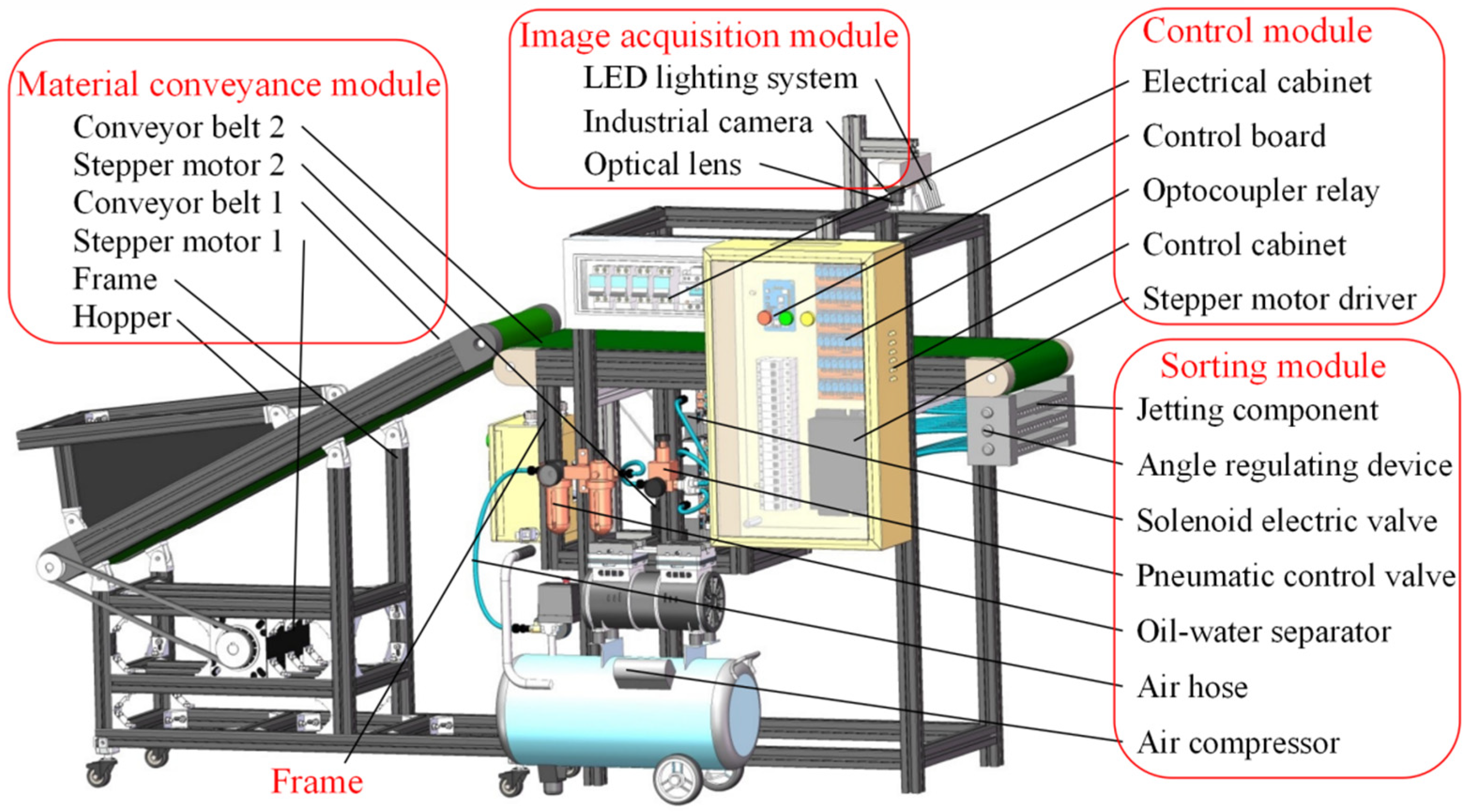
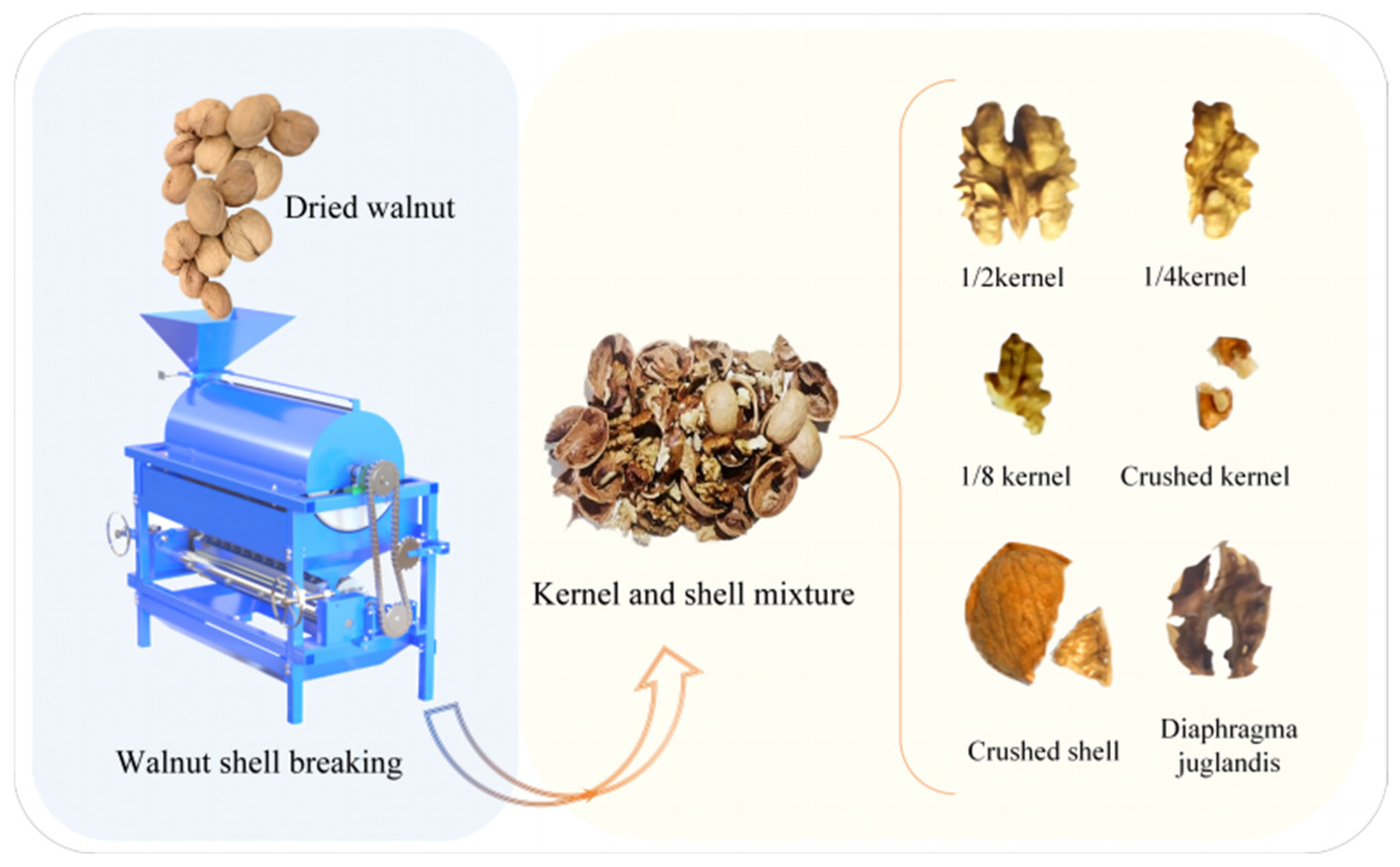

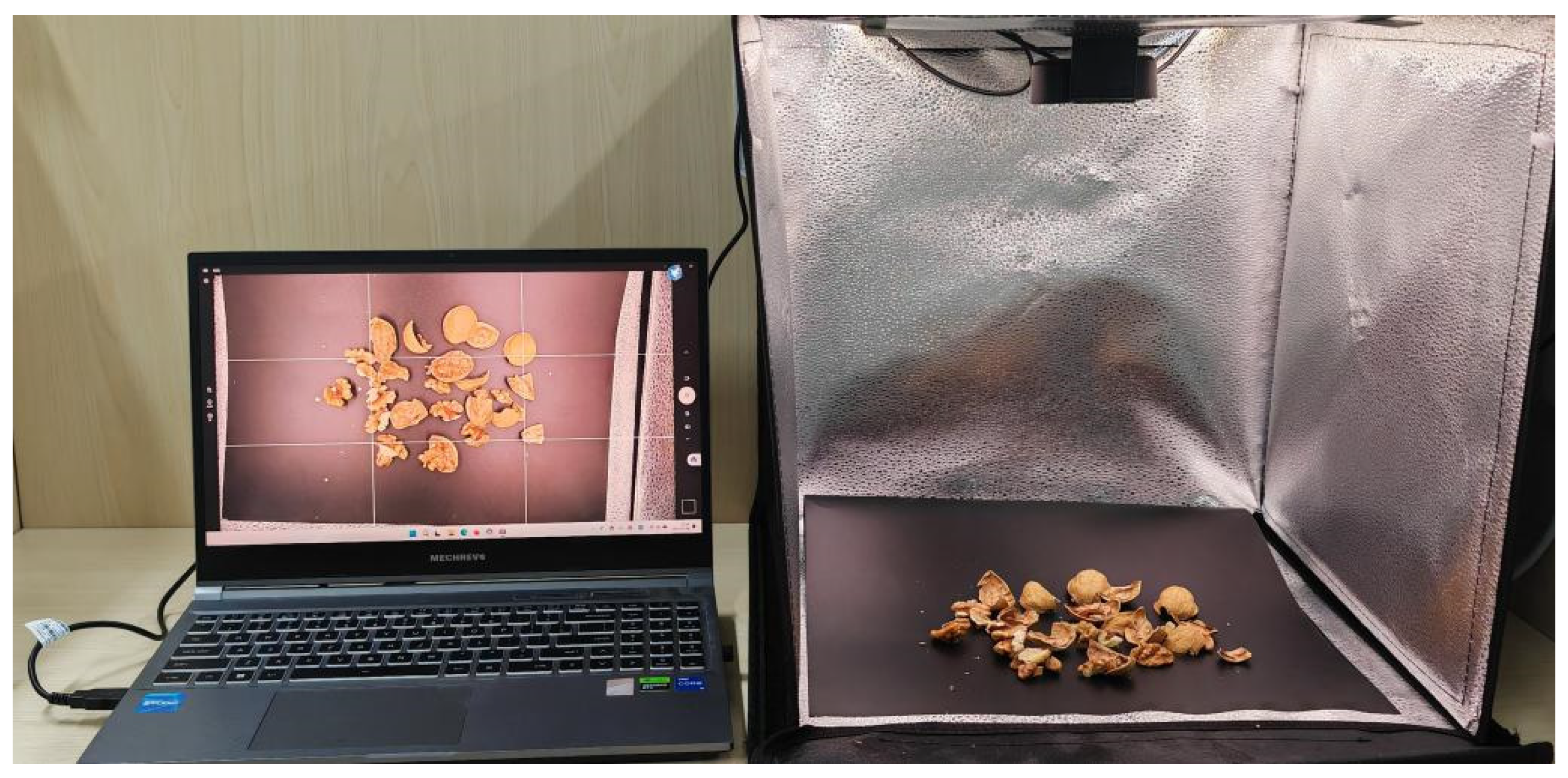
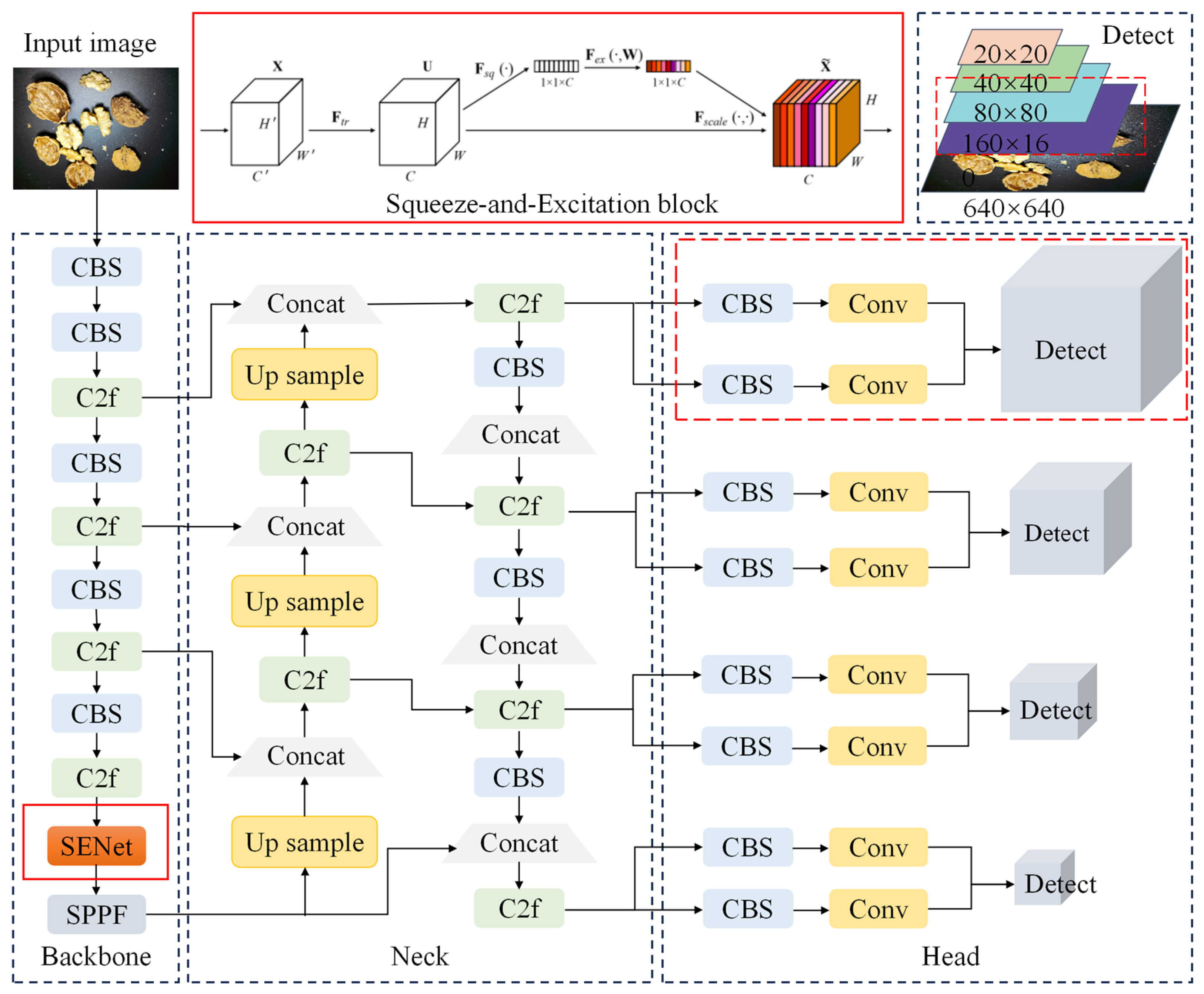
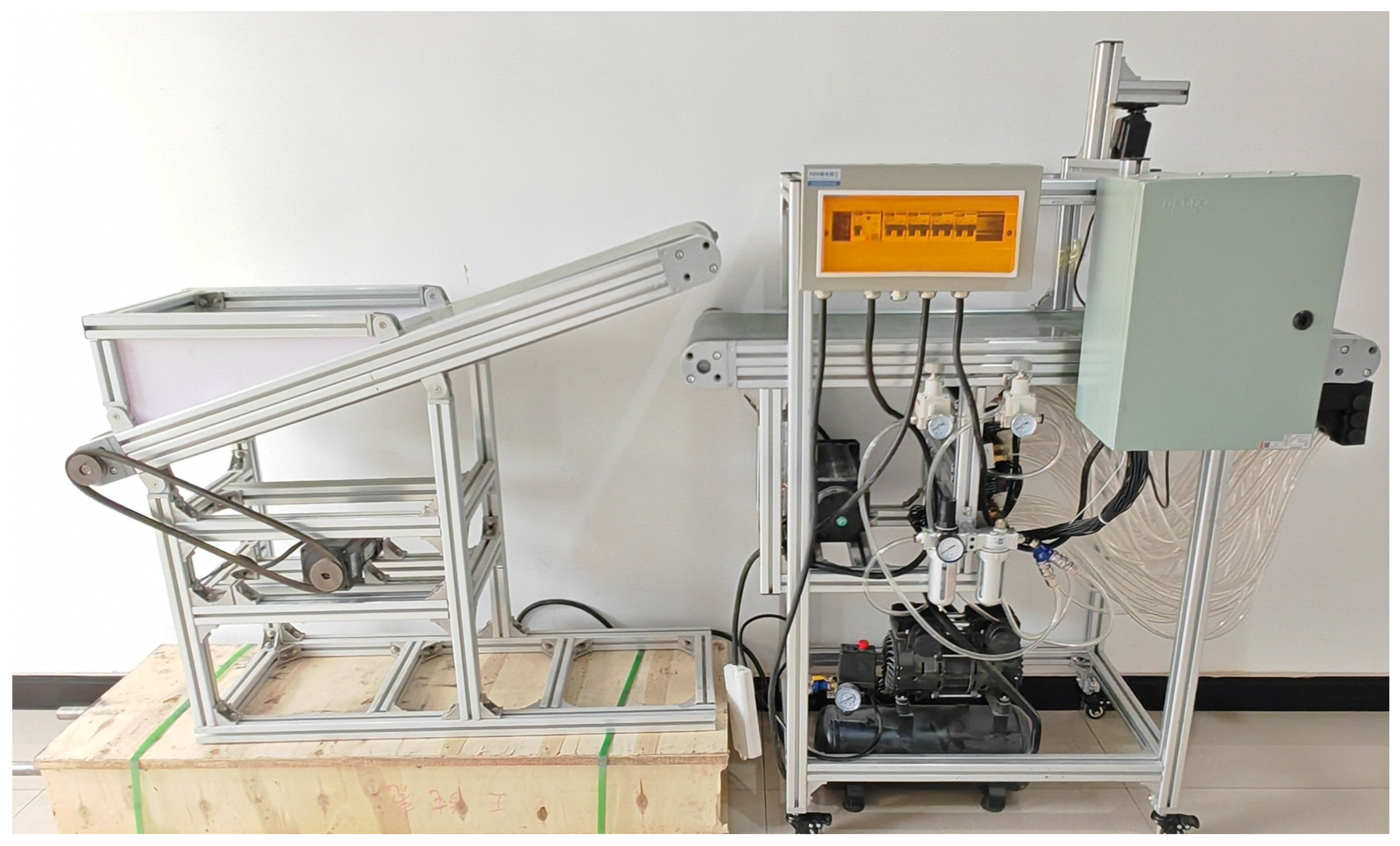



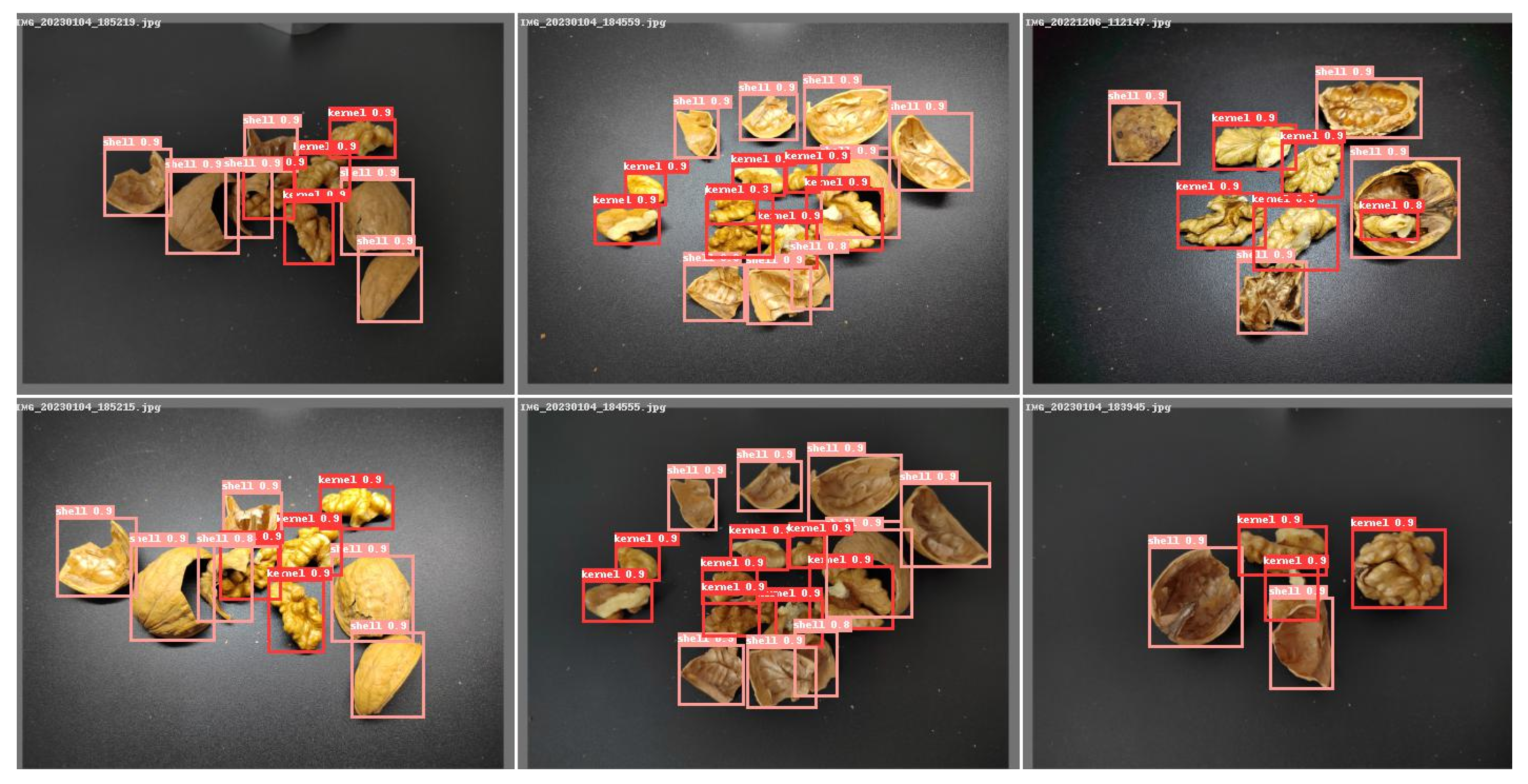

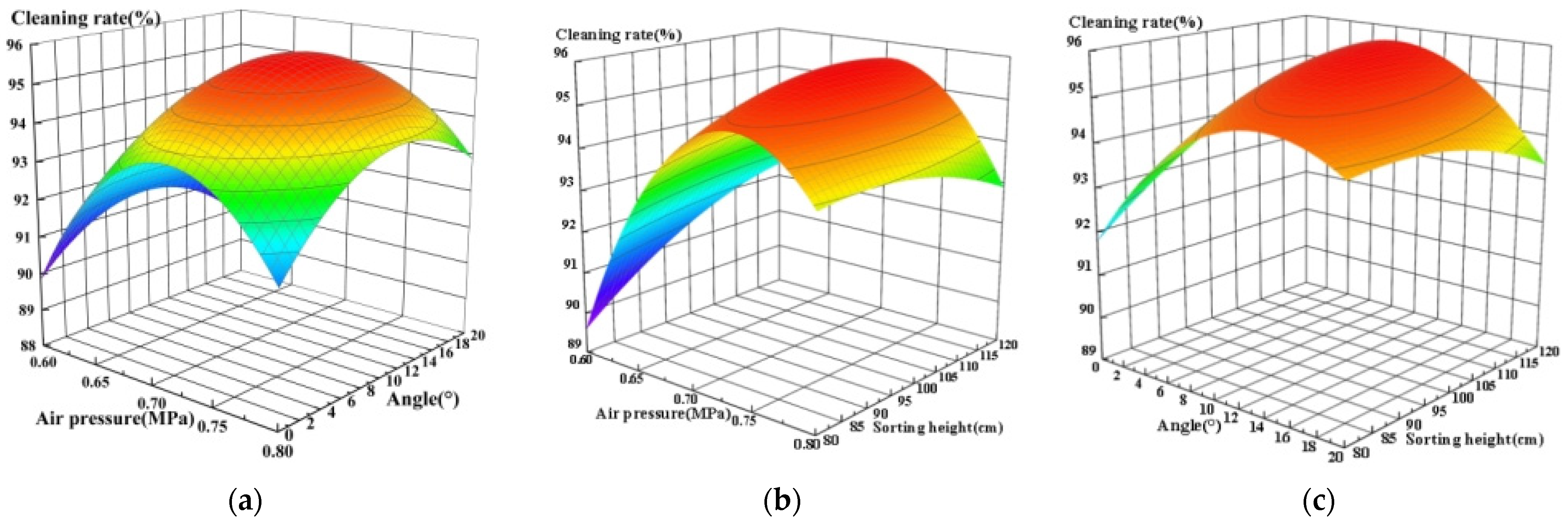
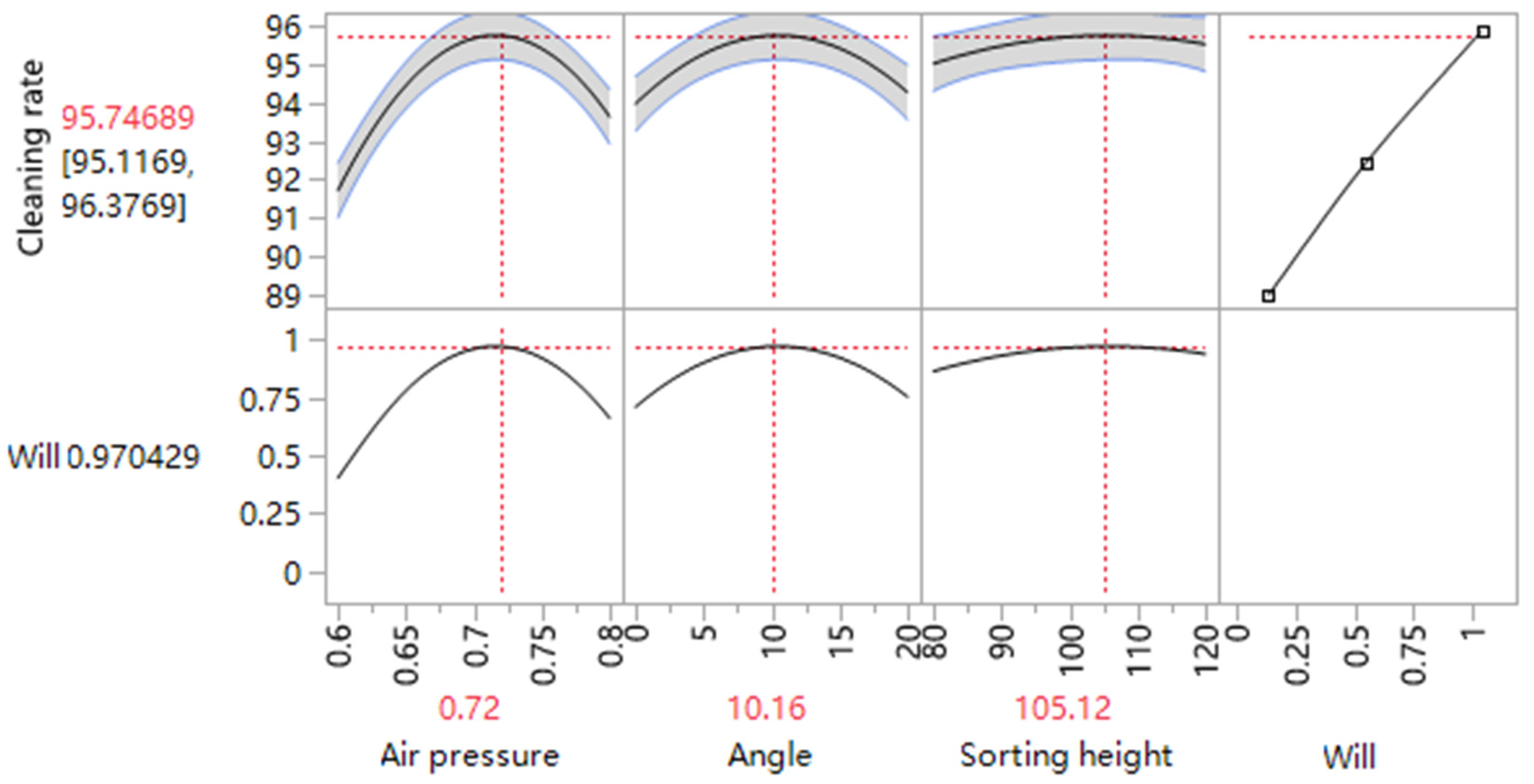
| Levels | Air Pressure (Mpa) | Angle (°) | Sorting Height (cm) |
|---|---|---|---|
| 0 | 0.6 | 0 | 80 |
| 1 | 0.7 | 10 | 100 |
| 2 | 0.8 | 20 | 120 |
| Material | Poisson’s Ratio | Shear Modulus (Pa) | Density (kg/m3) |
|---|---|---|---|
| Shell | 0.3 | 1.7 × 106 | 750 |
| Kernel | 0.3 | 1 × 106 | 980 |
| PU | 0.47 | 2 × 108 | 1200 |
| Material | Collision Coefficient | Static Friction Coefficient | Coefficient of Kinetic Friction |
|---|---|---|---|
| Shell–Shell | 0.2 | 0.7 | 0.01 |
| Shell–Kernel | 0.2 | 0.8 | 0.01 |
| Kernel–Kernel | 0.3 | 0.8 | 0.01 |
| Shell–PU | 0.33 | 0.71 | 0.09 |
| Kernel–PU | 0.39 | 0.59 | 0.28 |
| Algorithms | Precision | Recall | F1 | mAP50 | mAP50–95 |
|---|---|---|---|---|---|
| YOLOv8n | 0.979 | 0.974 | 0.980 | 0.983 | 0.840 |
| YOLOv8s | 0.980 | 0.972 | 0.981 | 0.984 | 0.842 |
| YOLOv8l | 0.985 | 0.987 | 0.982 | 0.987 | 0.844 |
| YOLOv8m | 0.979 | 0.980 | 0.981 | 0.986 | 0.843 |
| YOLOv8x | 0.987 | 0.977 | 0.982 | 0.988 | 0.845 |
| I-YOLOv8n | 0.988 | 0.986 | 0.987 | 0.991 | 0.846 |
| Faster R-CNN | 0.986 | 0.967 | 0.976 | 0.968 | 0.834 |
| Occlusion Conditions | mAP50 (%) | mAP50–95 (%) | R (%) |
|---|---|---|---|
| With | 98.9 | 87.6 | 98.3 |
| Without | 99.5 | 88.5 | 99.9 |
| Test No. | Air Pressure (Mpa) | Angle (°) | Sorting Height (cm) | Cleaning Rate (%) |
|---|---|---|---|---|
| 1 | 0.7 | 0 | 120 | 94.5 |
| 2 | 0.6 | 10 | 120 | 92.45 |
| 3 | 0.6 | 0 | 100 | 89.82 |
| 4 | 0.7 | 0 | 80 | 92.05 |
| 5 | 0.7 | 10 | 100 | 95.85 |
| 6 | 0.6 | 10 | 80 | 89.31 |
| 7 | 0.8 | 10 | 80 | 93.68 |
| 8 | 0.7 | 20 | 80 | 94.48 |
| 9 | 0.6 | 20 | 100 | 89.87 |
| 10 | 0.7 | 20 | 120 | 93.05 |
| 11 | 0.8 | 20 | 100 | 92.86 |
| 12 | 0.8 | 10 | 120 | 93.14 |
| 13 | 0.7 | 10 | 100 | 95.93 |
| 14 | 0.7 | 10 | 100 | 94.98 |
| 15 | 0.8 | 0 | 100 | 91.31 |
| Test No. | Parameter | Cleaning Rate (%) | Relative Error (%) | |||
|---|---|---|---|---|---|---|
| Air Pressure (Mpa) | Angle (°) | Sorting Height (cm) | Actual Value | Predicted Values | ||
| 1 | 0.72 | 10.16 | 105.12 | 93.56 | 95.15 | 2.19 |
| 2 | 0.83 | 10.02 | 115.0 | 92.91 | 95.19 | 2.28 |
| 3 | 0.83 | 5.0 | 107.03 | 92.58 | 95.0 | 2.42 |
| 4 | 0.9 | 10.02 | 107.03 | 92.54 | 94.89 | 2.35 |
Disclaimer/Publisher’s Note: The statements, opinions and data contained in all publications are solely those of the individual author(s) and contributor(s) and not of MDPI and/or the editor(s). MDPI and/or the editor(s) disclaim responsibility for any injury to people or property resulting from any ideas, methods, instructions or products referred to in the content. |
© 2024 by the authors. Licensee MDPI, Basel, Switzerland. This article is an open access article distributed under the terms and conditions of the Creative Commons Attribution (CC BY) license (https://creativecommons.org/licenses/by/4.0/).
Share and Cite
Ni, P.; Hu, S.; Zhang, Y.; Zhang, W.; Xu, X.; Liu, Y.; Ma, J.; Liu, Y.; Niu, H.; Lan, H. Design and Optimization of Key Parameters for a Machine Vision-Based Walnut Shell–Kernel Separation Device. Agriculture 2024, 14, 1632. https://doi.org/10.3390/agriculture14091632
Ni P, Hu S, Zhang Y, Zhang W, Xu X, Liu Y, Ma J, Liu Y, Niu H, Lan H. Design and Optimization of Key Parameters for a Machine Vision-Based Walnut Shell–Kernel Separation Device. Agriculture. 2024; 14(9):1632. https://doi.org/10.3390/agriculture14091632
Chicago/Turabian StyleNi, Peng, Shiqi Hu, Yabo Zhang, Wenyang Zhang, Xin Xu, Yuheng Liu, Jiale Ma, Yang Liu, Hao Niu, and Haipeng Lan. 2024. "Design and Optimization of Key Parameters for a Machine Vision-Based Walnut Shell–Kernel Separation Device" Agriculture 14, no. 9: 1632. https://doi.org/10.3390/agriculture14091632
APA StyleNi, P., Hu, S., Zhang, Y., Zhang, W., Xu, X., Liu, Y., Ma, J., Liu, Y., Niu, H., & Lan, H. (2024). Design and Optimization of Key Parameters for a Machine Vision-Based Walnut Shell–Kernel Separation Device. Agriculture, 14(9), 1632. https://doi.org/10.3390/agriculture14091632







